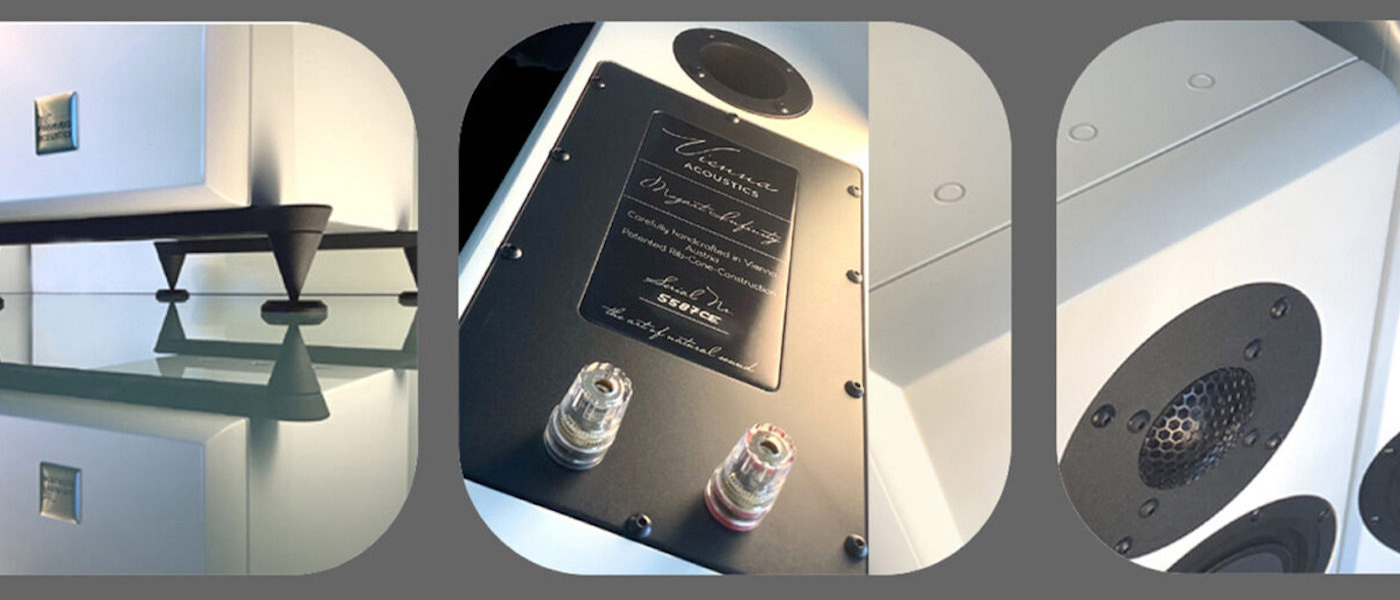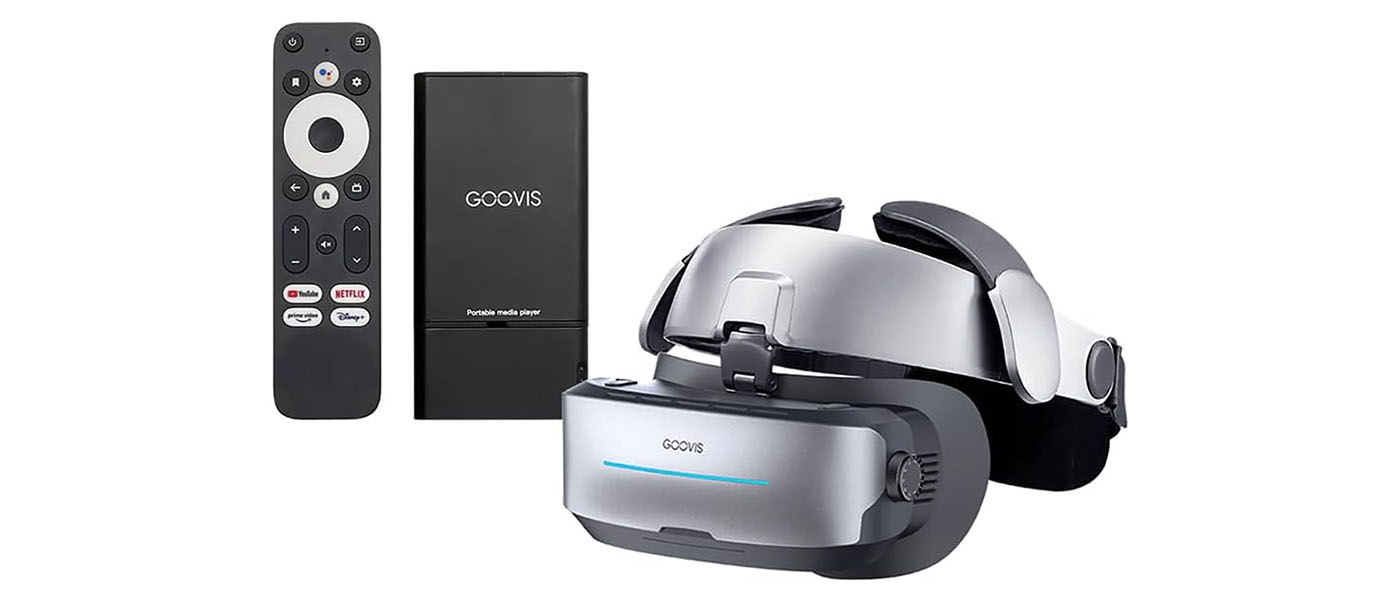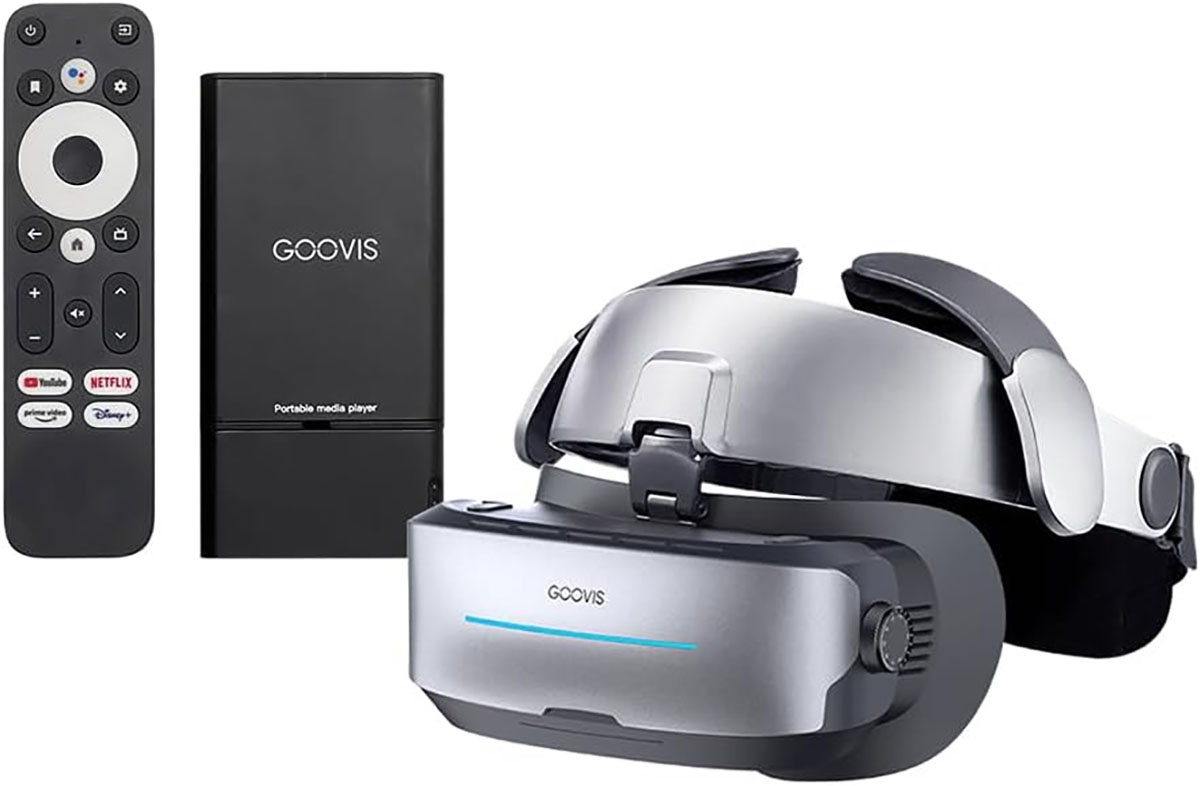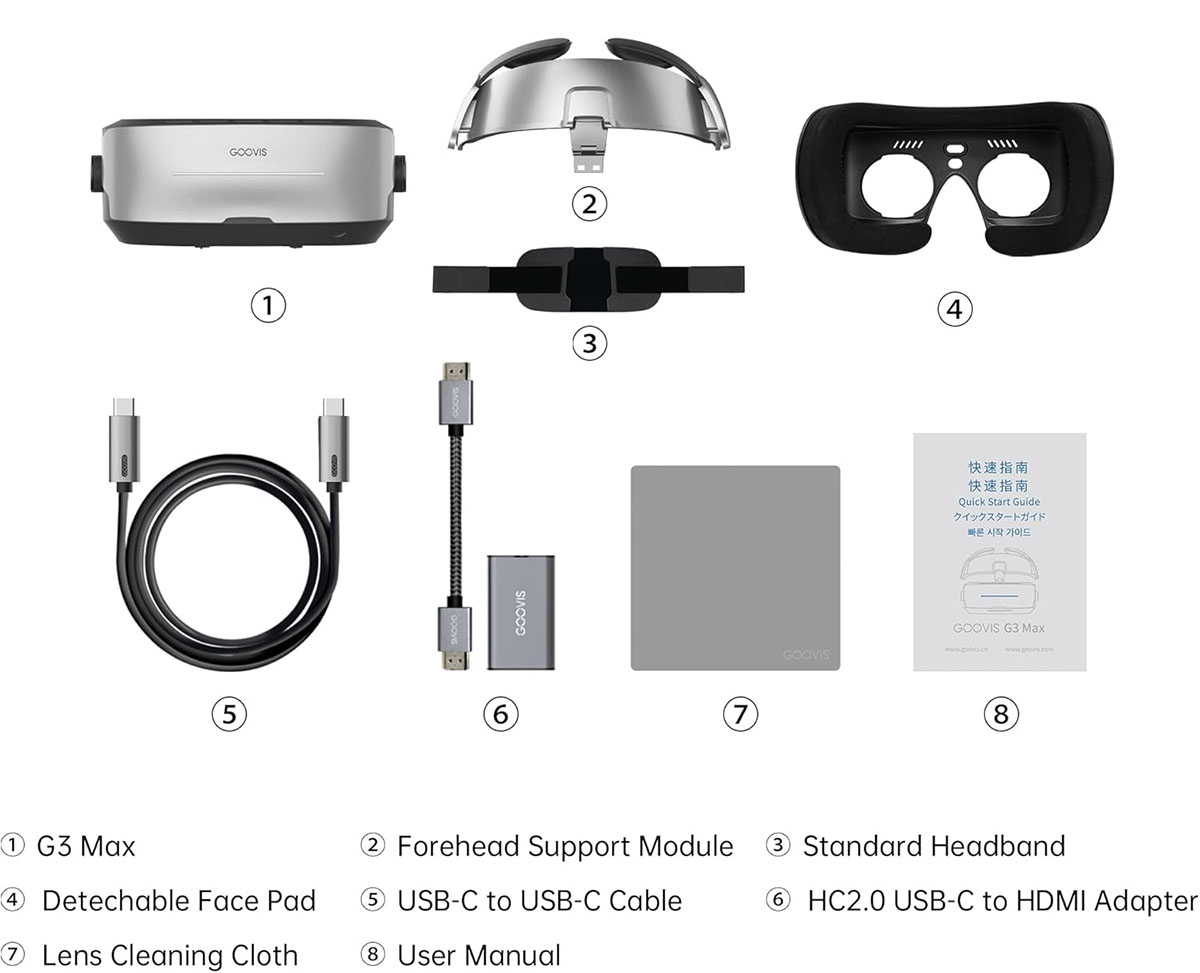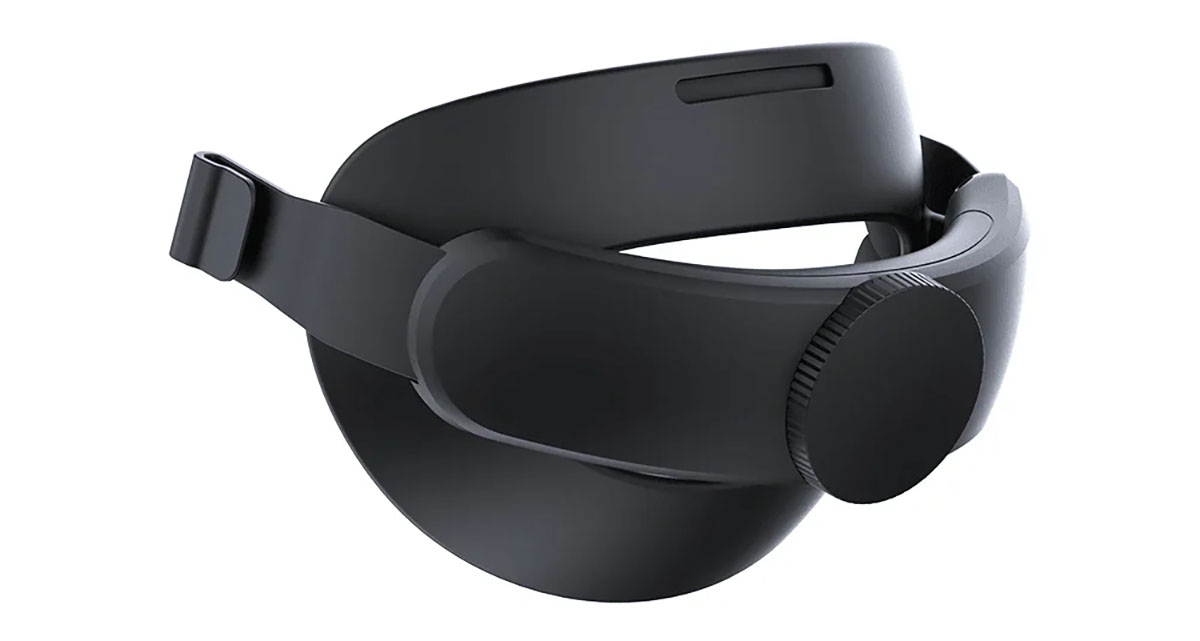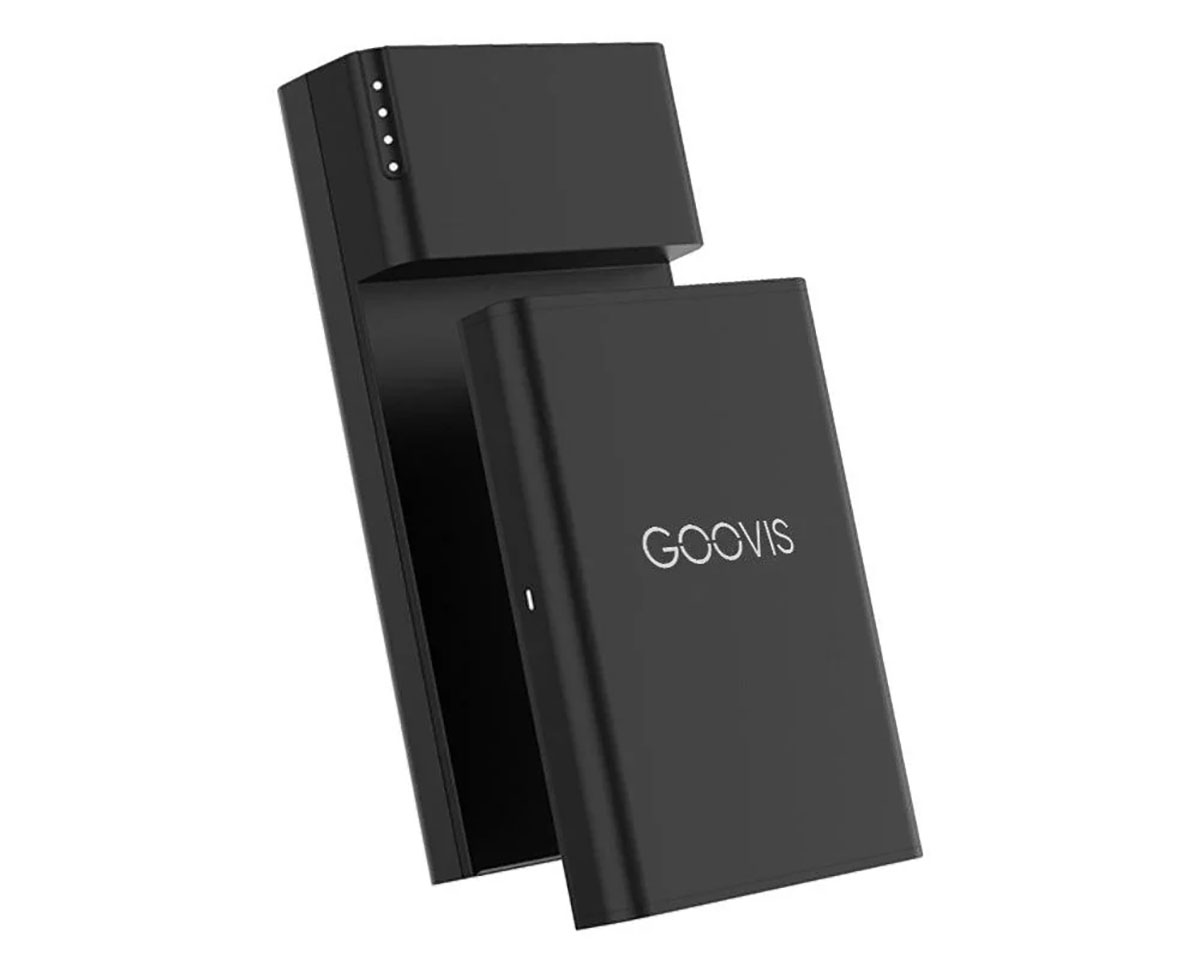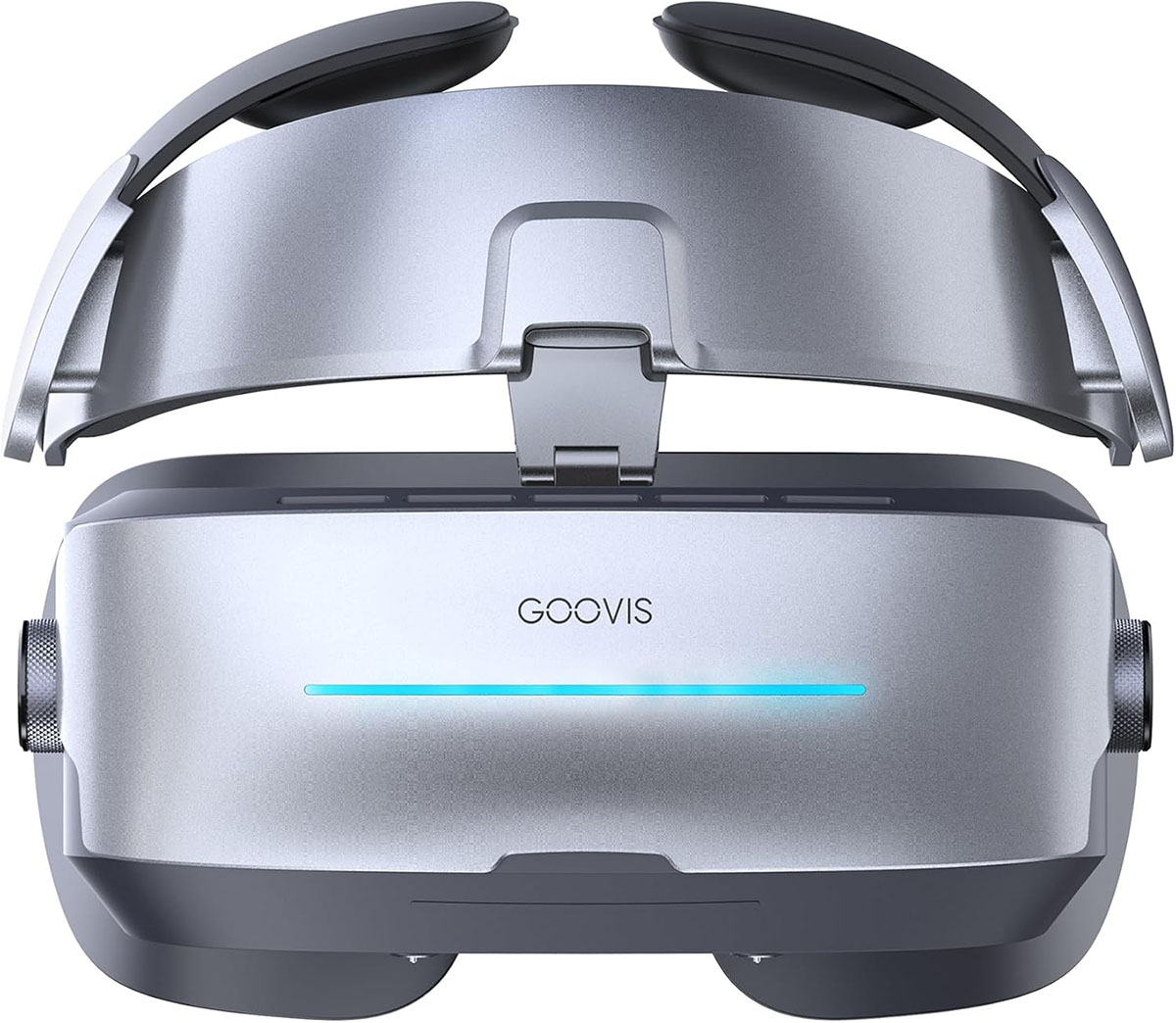It’s a 3D-capable wearable OLED TV.
The GOOVIS Max 3D Head Mounted Display is a wearable headset display with 5K resolution (two times 2560 x 1440), OLED technology, 3,528ppi pixel density, 3D support, and integrated audio. The $1,199 top-of-the-line package has everything you need to start watching, including an Android TV dongle. It’s all powered by a three-hour battery, so you aren’t tethered to a wall outlet. You can also connect it to other streaming boxes or a disc player.
GOOVIS G3 Max 3D Head Mounted Display
- Dual Micro OLED headset display with 5K (2560×1440 per eye) resolution
- 3,528 pixels per inch density, 46 pixels per degree of view
- 3D Blu-ray support
- Three-hour battery power for display and Android dongle with Bluetooth remote
- Audio through integrated speakers, headphone jack, or Bluetooth
- +2.0 to -7.0D Diopter adjustable eyepieces for eyeglass wearers.
- Some assembly required
Head-mounted displays are nothing new, but if you look at the history of virtual reality and wearable technology, you’ll find a lot of products have come and gone over the past 10 years. The idea of a personal home theater is attractive, especially if you don’t have the space or budget for a jumbo screen with surround audio.
I’ve reviewed displays of all sizes, ranging from small portable monitors to large format TVs and projectors. This is my first foray into wearable tech. The GOOVIS Max 3D Head Mounted Display puts a tiny OLED screen in front of each eye, each with 2560 x 1440 resolution and a pixel density of 3,528 pixels per inch (PPI), or 46 pixels per degree (PPD). That’s many times denser than any traditional display can boast. It also includes integrated speakers and a headphone jack if you’d rather provide your own audio solution. Power is via external battery, so you aren’t tethered to your chair, and the whole kit is portable. The top-of-the-line package sells for $1,199 and includes an Android TV dongle. Let’s take a look.
Type:
Dual-screen Micro OLED headset
Screen size:
0.83 inch
Resolution:
2560 x 1440 per eye
Input signal:
up to 3840 x 2160 @ 60 Hz
Pixel density:
3,528ppi
Pixels per degree of view:
46ppd
Max refresh rate:
120 Hz
Response time:
0.01ms
Color gamut (mfr.):
95% DCI-P3
3D format support:
side-by-side, frame pack
Field of view:
65 degrees
Optical adjustment:
L/R diopter & pupil distance
External battery life:
3 hours
Video input:
USB-C w/included HDMI 2.0 converter
Weight:
300 grams (10.6oz)
Price as tested:
$1,199
Website:
Company:
SECRETS Tags:
GOOVIS, g3 max, head mounted display, wearable display, micro oled, vr goggles, virtual reality
Secrets Sponsor
The technology behind the G3 Max is super cool. When I was approached for this review, I stopped reading at “Micro OLED.” OLED (Organic Light Emitting Diode) is my favorite display technology for several reasons, the first of which being its infinite contrast. Dynamic range is king in my world, and OLED has more than any other display type.
The two OLEDs here are 0.83-inch diagonal and contain 2560 x 1440 pixels each. That makes the total pixel density 3,528ppi or 46ppd, which is far greater than any TV or monitor can boast. Of course, you’re viewing the screens from just millimeters away, so this kind of density is a must if you’re going to see a clear image. The G3 Max delivers extremely well on that score. It uses a proprietary video processing solution to scale incoming signals to its native resolution.
Optically, the G3 Max mimics the field of view of a 1,000-inch (a bit over 83 feet) screen from 65 feet away, which translates to a 65-degree value. This is well above the THX-recommended 40 degrees and is in fact close to the IMAX average of 70 degrees. That’s nearly all of most people’s peripheral vision. Though you can see the edges of the image in the G3 Max, it’s barely noticeable when watching content.
The optics are of very high quality with six-element lenses and adjustments to ensure the sharpest possible image. Each eyepiece has a diopter dial so you can tweak it for eyes that are asymmetrical. I’ve worn glasses since age 16, and my eyes have different correction factors, but I had no trouble getting the picture perfectly clear. You can also adjust the distance between the lenses to get them in line with your pupils, and this too was a simple matter.
Audio is covered here, too, with a pair of integrated speakers that fire in the direction of your ears. I won’t pull punches here; the sound is poor at best. It is very tinny and even at max volume, it’s barely audible. It’s also audible to people nearby. Luckily, there’s a 3.5mm headphone jack to which I connected a pair of wired earbuds. You can also use wireless solutions through Bluetooth.
GOOVIS sells a number of different kits, but the G3 Max is the flagship. The package I received had a few extras. The base setup includes the headset, an Android TV dongle with battery, and an HDMI to USB-C converter. It costs $1,199. I also got a more substantial headband ($59) and an additional power bank battery ($99).
The main component is the display, which has a large soft rubber mask to block light. It attaches to a substantial headband, which is both light and comfortable. An elastic headband is included, but I got a rigid one with a click adjuster that makes the package even more comfortable.
To get power and video in, there’s a USB-C connector on the right side that hooks to a small HDMI converter. This tiny box then connects to a power bank with an 8000mAh battery. The power bank accommodates either an Android TV dongle or a video passthrough part if you want to connect to a Blu- ray player or another streamer like an Apple TV. The battery is good for around three hours, or you can plug into a USB-C wall wart like what you’d use to charge an iPad.
The carton I received had all the parts in separate boxes. If you’re good at figuring things out without instructions, it’s easy to see how it all fits together. There are a couple of small manuals, but they weren’t much help. Luckily, GOOVIS has a few videos on their website to help you connect to things like a PS4, Nintendo Switch, or drone camera.
My first task was to get it all assembled. It’s not too hard, as there is only one way to make everything fit. The display block snaps into the headband. Then you hook in the back part, either the elastic one that’s included or the rigid version. I highly recommend spending the extra $59 to get the rigid headband with its click adjuster.
Getting power and video in took me a little longer to work out. There’s an HDMI adaptor, but it doesn’t have internal power, so it needs to be connected to something that provides it, like the power bank or a source device with power over USB. I started with the Android dongle, which has an HDMI output. That goes to the converter, then a USB-C cable goes to the headset.
After hearing the internal speakers during my initial audition, I quickly reached for a pair of wired earbuds to hook into the 3.5mm headphone jack. I also had success with Apple AirPod Pros connected via Bluetooth.
The Android dongle ran me through its setup routine, which included prompts to adjust the diopter dials at the sides. When you turn them, the screen shows a number that you can focus on to find the sharpness sweet spot. The dials are precise, and after a minute, I had a very sharp picture. I also had to fiddle with the position of the display on my face. Getting the rubber mask to completely block outside light is important because it also sets the OLED screens at an ideal distance so that the image is sharp from edge to edge.
There are three controls on the headset: one for brightness (luminance), one for volume, and a 3D signal toggle. The G3 Max does not convert 2D video to 3D, but it does support 3D content in side-by-side and frame pack formats. I also noted that there is no HDR10 or Dolby Vision support. You can change the image size by holding the volume up for three seconds. This shifts your field of view and reduces resolution to 1080p, which isn’t necessarily bad, as I’ll explain in a moment. Holding brightness down for three seconds changes the overall luminance but doesn’t shift the black and white thresholds. I’ll explain that below as well.
Before playing content, I connected an Accupel signal generator to check out a few patterns and learned two things. First, the G3 Max outputs only PC white and black thresholds, i.e., levels 0-256 rather than video 16-235. That means any source device needs to be set to PC levels if the image is to look correct. That’s no problem for streaming boxes like Apple TV or Android dongles, which typically set themselves up according to the display’s internally stored parameters (EDID). But my Panasonic DP-UB9000 required a visit to the settings menu. Second, the sharpest image is when you set the screen to its smaller size. It turns out this is 1080p, which is a whole number division of 2160p, AKA Ultra HD. Though you see a smaller image, it is a tad sharper. Of course, the larger image is sharp too. I’ll talk more about that below in my subjective evaluation.
If you’ve used Android TV before, the experience of the G3 Max and D4H1 Portable Media Player will be familiar. Oh, except for the part where you can’t see the remote control. That took a little getting used to at first. You can easily flip up the display to look down, but you’ll want to memorize the buttons to avoid doing that too often. Getting the display positioned just right is important, so once you’re settled, you won’t want to move it. I also noted that when you remove the headset, the audio and video shut off. They return very quickly when you put them back on.
I noticed that my head movements were visually perceived. Yes, the image follows you, and it was a little unnerving at first because nearly all my peripheral vision was covered, and I sometimes moved my head habitually to see action at the edges of the screen. GOOVIS has thought of this, though with an option to shrink the image.
And that takes me to a question that is no doubt on some of your minds. What is the effect of viewing 1080p and 2160p content on a 1440p screen? I have done this many times on computer monitors, and in those cases, it is not ideal because 1440 is not a whole number multiplier. When the image is large, it’s QHD or 2560 x 1440. It’s incredibly sharp, but if you view a one-pixel multiburst pattern, you will see a slight loss of resolution. If you shrink the image, it becomes 1080p, and the pattern resolves fully. In practice, the sharpness difference is minute. But after watching for a while, I found the smaller picture less fatiguing because I could focus on all of it. The larger image makes you want to move your head as you would in a large-format cinema like IMAX. And you don’t want to do that. Keeping my head still gave me the best experience.
In practice, the G3 Max is very much like watching a jumbo screen. A 65-degree field of view is the same as sitting 3.7 feet from a 65-inch TV. That’s IMAX territory, and it is not what one typically experiences at home or in a regular cinema. It took me some time to acclimate, but the image quality is excellent. Color is rich and vibrant, and though I couldn’t run any instrumented tests, it looked accurate given my experience. Motion processing is very smooth, and there were no visible artifacts in video shot at 24, 50, or 60 fps.
I watched a few selections on Apple TV through Netflix. It outputs 2560 x 1440, which made the picture very sharp as the G3 Max didn’t have to scale. It also set the black and white levels correctly. Color was incredibly lifelike and vivid. Though HDR is not supported, it uses an expanded gamut for all content, which covers a claimed 95% of DCI-P3. I could not measure this to verify, but my eyes saw no reason for doubt. Again, I noted how incredibly sharp the image was. I found I had to reset my brain to focus on such a perceptually large picture that was as clear as the 65-inch OLED TV in my living room.
Watching the latest seasons of NASCAR Full Speed and Outlast really showed the G3 Max’s capability. Netflix is well known for its high-quality content, and here, it was incredibly clear and realistic. Between the superb optics and the Micro OLED’s tremendous contrast, it was hard to imagine better. Blacks were deep and true with fine detail, while highlights popped and gave the image a 3D quality. Textures took on a tactile feel to where I felt I could reach out and touch objects in the foreground.
It’s a bummer that the G3 Max doesn’t support HDR because the SDR content I watched was amazing. I started with the last chapter of Mission: Impossible – Dead Reckoning Part One. Though I only had it in Ultra HD HDR format, my Panasonic player downconverted it to SDR cleanly. Color was clean and natural, and not overblown despite the extra gamut volume in play. Playing surround audio through earbuds worked well, too. The G3 Max passes surround codecs through with an effective two-channel conversion, so all the spatial cues were present. Sound panned across the front stage and behind as well.
Casino Royale is, by today’s standards, an oldie but goodie. The transfer is somewhat grainy, especially during the opening black-and-white sequence. The G3 Max kept it from getting too crawly while avoiding any excessive smoothing or smearing. It presents a clean image free of obvious processing but keeps the frame rate smooth.
3D is a new experience on the G3 Max. Though it’s technically glasses-free, you’re wearing the display, so I’ll leave that up to your interpretation. The effect is super cool, though. I saw Avatar in IMAX 3D when it came out, and this headset took me back to that theater in Nashville in 2009, where I enjoyed it from a perfectly positioned seat. If you’re a fan of 3D, there is no better way to enjoy it than the G3 Max. There was no crosstalk visible and no distortion. The picture was sharp and colorful with the deepest contrast and very high brightness, far more than any 3D projector is capable of. I could see a display like this rebooting the format. It’s the best way to experience its full capabilities.
Secrets Sponsor
GOOVIS’ G3 Max 3D Head-Mounted Display delivers premium imagery. At $1,199, it isn’t cheap, but it’s far less than competitors like Apple’s Vision Pro.
- Incredibly sharp, colorful, and bright image
- Premium video processing
- Excellent accommodation for eyeglass wearers
- Lightweight and comfortable with solid build quality
- Decent value
- HDR support
- Easier setup with better instructions
- Better integrated sound
The GOOVIS G3 Max 3D Head-Mounted Display is one of the coolest things I’ve seen. Coming from a purely videophile perspective, it’s a compelling choice for personal viewing. Compared to a projector, it delivers a much sharper image with a field of view that I could never reproduce in my home. With incredible contrast and vivid color, it’s like watching a premium OLED TV from less than four feet away. Thanks to solid color tuning and very high-quality optics, its raw performance will be hard to top by any traditional display.
Comparisons are difficult since it is my first time reviewing a headset display. The G3 Max is certainly a good value when you compare it to Apple’s Vision Pro, which starts at $3,499 and doesn’t have the optical adjustability GOOVIS provides.
It is certainly light and comfortable, and very portable. Weighing less than a pound, it won’t be fatiguing to wear through a full-length movie or long gaming session. My main critiques are with its setup, which I found fiddly. The included instructions weren’t terribly helpful, and it required quite a few cable connections when used with a Blu-ray player or streaming box. If you have a source with USB-C output, it’s a piece of cake, but HDMI creates a few more steps. I also noted very poor sound from the integrated speakers. It might have been better to save a few grams and leave them out. The headphone jack and Bluetooth connection are more than adequate for any earbuds the user provides.
Given the G3 Max’s bleeding-edge status, I can forgive the flaws I encountered. The bottom line is that it works very well at providing premium-quality video in a wearable product for a reasonable price. If you can’t install a theater at home or you’re missing that special space while traveling, the GOOVIS G3 Max 3D Head-Mounted Display is well worth considering.


